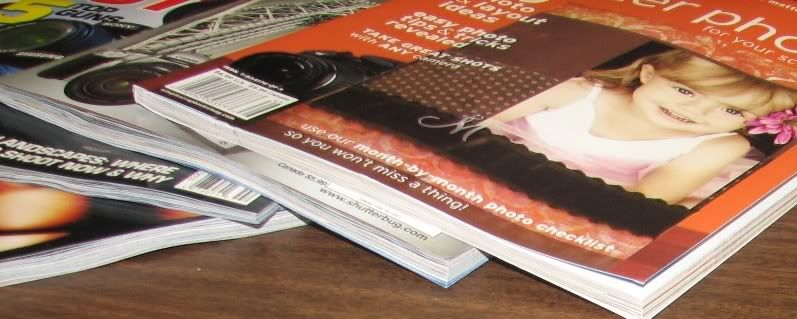
Last night (January 9) I took a class at the LSS for beginning digital photography and learned quite a bit! Granted, some if it was very basic, but it was well worth the $13.50 I spent. :) Here are some of what I learned.
- Hold the shutter half down to focus on what you want to take the picture of, then when you take the picture, EXHALE. When you exhale, it steadies the picture and the picture turns out better.
- Don't use Zoom as often as you think you should. Use your feet first. Move closer to your subjet rather than use the zoom, if possible. You also become more involved in your pictures that way. The more you zoom in, 75% less light gets through the lens, and the flash is less effective. The pictures turn out darker. The more you zoom, the higher chance you have of pictures being blurry beause you must hold the camera steadier while shooting.
- Make sure that your settings are on the highest Megapixle on your camera and on superfine. Yes, your memory card holds fewer pictures, but the quality is MUCH better.
- Use your flash on EVERY picture you take with people smiling. Even if it's outside and sunny, the pictures turn out better.
- If you have your camera on Auto, it makes all the decisions for you. Jeff (our instructor) had us turn our camera to "P" beause we have more options for flash and exposure and to leave it there for 2-3 months. Notice the difference in your pictures.
- Warn people what the camera is going to do when using the flash. That way they can be prepared for it. The flash works only between 10-12 feet. Anything over that use your feet and move closer to your subject.
- Make sure you focus between the eyes of the subject. If the eyes are in focus, the picture will look in focus. If the eyes are not in focus, the picture will not look in focus.
- Other reasons for using the flash, is to illuminate the subject, even out the shadow and make sure the flash on your camera goes toward where the shadow is. It elimiates the shadow. The flash also balances the color out in artifical lighting. The flash also makes the background darker, and focuses on the subject.
- Don't use the flash on reflected surfaces that you can't avoid, of if the subject is out of range. (Use your feet, move closer to the subject and use the flash)
- ALWAYS use the strap on your camera.
- Say that you are going to shoot on 3, but really shoot on 2. Much better pictures that way. If your subject realizes what you are doing, start shooting on 3 then.
- Shoot loose! Don't zoom in to get a close picture. You have megapixles to spare, so shoot loose and don't zoom as much. You can always crop more, but you can't un-zoom after the picture is taken!
- Use the rule of thirds when taking pictures. Think tic-tac-toe. The pictures are much more visually pleasing, and if you watch TV, or look at ads or anything, the majority of the pictures are taken using the rule of thirds.
- He suggested not using places like Target, Sam's, and Wal-Mart to print your pictures. The quality is not consitent and his sister has pictures that are 5-10 years old that she had printed at Sam's or Wal-Mart and he has pictures that he printed at Ritz and Proex and his pictures are not faded and hers are. He showed examples of this, and after seeing the examples, I will only get my pictures printed at quality photo places even though it is more expensive. At Ritz he said you can pre-pay for 300-500 prints at 19 cents a print for 4x6's and you can pre-pay for 50 5x7's at 79 cents a print. Not that much more and you can ensure that the quality is consistent and they will not fade.
- He also said that the point & shoot cameras last only about 5 years, the Canon SLR calendars 10 years, and the Nikon SLR cameras about 15 years. I thought that was interesting.
- He also suggested in investing in a quality 1 GB or higher memory card. He said that some brands would be Lexar, Panisonic, San Disk Ultra 2 or 3. Any card that is made in Japan is decent, but if you have any cards made in China re-invest. Your memories are worth it.
- He also said that if you accidentally reformat or delete pictures off your card that you want. DO NOT take any more pictures using the card. For every 1 picture that you take, an additional 20 are lost. You can bring your card into a high quality photo shop and they should be able to recover the information for you. Jeff said that he can recover generally 95% of all the pictures.
- We also went over some settings. Macro (generally the flower icon) is used for close up pictures. For Night settings, the shutter stays open longer, so make a 4x4 inch beanbag to use as a "tri-pod" to stabalize the camera. The mountain setting is the setting that you use to take a picture on what's outside rather than inside, generally through class. Also, when taking a picture through glass, angle the camera, and that will help the picture turn out better.
I hope that some of these tips that I learned at my class help you. I know they did me! Especially since I'm doing the photo a day. Oh, speaking of photo a day, I was playing around with my camera a bit in class, and took that picture. I thought it turned out neat. :)

2 comments:
excellent advice and thankyou for sharing it
Taffy
Your welcome Taffy!
Amber :)
Post a Comment